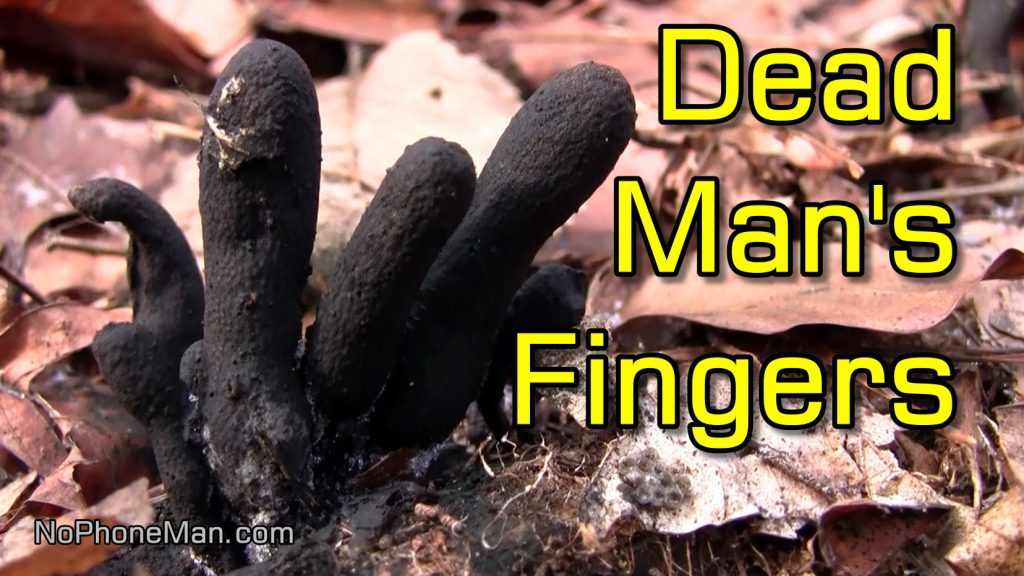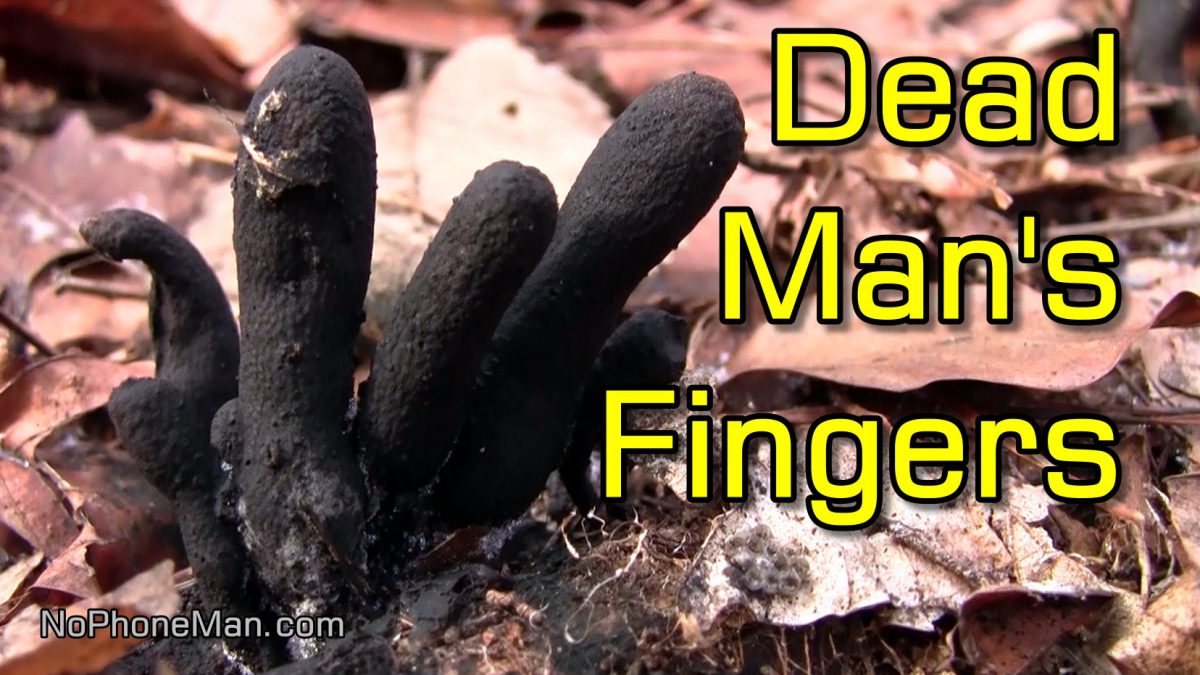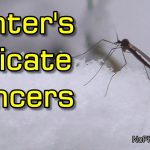
The world of fungi is full of peculiar and fascinating life forms, and one such curiosity is the Dead Man’s Fingers fungus, scientifically known as Xylaria Polymorpha. This rather distinctive fungus, with its almost eerie appearance and mysterious qualities, captures the imagination of nature enthusiasts and mycologists alike. Here’s the story captured in the video:
It’s already winter, and it was crispy -10 degrees Celsius outside but there was no snow on the ground when I was out in the woods harvesting pine cones which have fallen from the trees. My fingers were really feeling the freeze as I picked up the ice-cubes-cold cones from the frozen ground, often needing to yank on them hard to detach them as the frost as-if glued them onto the forest floor. I harvest the pine cones to use them as mulch for my Blueberry raised bed. Blueberries prefer a slightly more acidic environment and so do the pines, so their cones, which are no longer on the trees, work great for that. The fallen pine cones often have pine needles alongside them too, so I harvest those as well as both function well as mulch for Blueberries.
Having had my focus on the ground to collect the cones, my attention was attracted by an innocuous fungus, which I would have otherwise missed had I not concentrated on what’s on the ground. Blending well with litter from both the deciduous and coniferous trees, one could easily walk right beside the fungus and not notice it. But my mission to collect the pine cones had me pay close attention to what’s on the ground so I spotted it and since the fungus in question is a very cool one to come across, I decided to film it and share the information about it as well as what it looks like with you, guys.
It was Dead Man’s Fingers (Xylaria Polymorpha). I filmed the fungus to show what it looks like, described its appearance to help with identification, mentioned how its color changes as it matures, showed that it grows out of a decomposing long, that it grows in groups (called “troops“), mentioned its uses and then picked one “finger” off to slice it in half, in order to show the firm white insides of the fungus, along with the closeup of the little spores containing spheres along the mushroom’s dark surface.
Overall the video showcases the fascinating and enigmatic fungus but also contains all relevant information a practical forager my need to know in order to identify the fungus and know how to use it.
Dead Man’s Fingers Appearance and Identification
Xylaria polymorpha gets its common name, Dead Man’s Fingers, from its gnarled and finger-like black fruiting bodies. These elongated structures, resembling the digits of a hand, emerge from the decaying wood of fallen trees. The fungus starts as a whitish mass that darkens over time, creating a stark contrast against its natural surroundings.
Identifying Dead Man’s Fingers is relatively straightforward due to its unique morphology. The finger-like structures can range in size from a few centimeters to over 20 centimeters, and they often grow in clusters. The surface of the fungus is typically rough and textured, resembling charred or burnt wood.
Dead Man’s Fingers Habitat and Geographic Distribution
This intriguing mushroom is widespread and can be found in various habitats, primarily where dead or decaying wood is present. Dead Man’s Fingers are commonly spotted in deciduous and coniferous forests, as well as woodlands and parks. The fungus has a broad geographic distribution, being found in North America, Europe, Asia, and other regions with suitable environmental conditions.
Dead Man’s Fingers Life Cycle and Growth Patterns
Xylaria polymorpha is a saprophytic fungus, meaning it obtains nutrients by decomposing dead organic matter. Its life cycle involves the release of spores from the tips of the finger-like structures, allowing for the dispersal and colonization of new substrates. The growth of Dead Man’s Fingers is most prolific during the autumn and winter months, coinciding with the period of increased moisture and cooler temperatures.
Dead Man’s Fingers Edibility and Culinary Significance
Despite its ominous name and appearance, Dead Man’s Fingers are not considered toxic to humans. However, they are not known for their culinary appeal either. The tough and woody texture of the fungus makes it unpalatable, and it lacks the desirable flavors associated with edible mushrooms. As a result, it is not commonly foraged or consumed.
Dead Man’s Fingers Chemical Composition and Medicinal Potential
Studies on the chemical composition of Xylaria polymorpha have revealed the presence of various bioactive compounds. While not commonly consumed as food, some cultures have explored the medicinal potential of this fungus. Research suggests that certain compounds found in Dead Man’s Fingers may have antimicrobial and antioxidant properties, opening avenues for further investigation into its potential pharmaceutical applications.
Dead Man’s Fingers Ecological Role and Decay Process
Dead Man’s Fingers play a crucial ecological role in forest ecosystems by participating in the decomposition of dead wood. As saprophytes, they break down complex organic compounds into simpler forms, returning nutrients to the soil. This decomposition process is essential for nutrient cycling and the health of the forest ecosystem.
Dead Man’s Fingers Curiosities and Folklore
The distinctive appearance of Dead Man’s Fingers has led to various folktales and superstitions. In some cultures, the fungus is associated with mystical or supernatural beliefs. Its presence on a fallen tree may evoke thoughts of a ghostly hand reaching up from the underworld. While such stories may be more fiction than fact, they add an element of mystique to this already enigmatic fungus.
Does Xylaria Polymorpha Glow in the Dark?
Xylaria Polymorpha does not exhibit bioluminescence. Unlike some other fungi that possess the ability to glow in the dark, such as the well-known species Armillaria Mellea (commonly called Honey Fungus), Xylaria Polymorpha does not produce light.
Bioluminescence in fungi is often associated with the presence of luciferin, an enzyme that facilitates the oxidation of a light-emitting pigment. While the Dead Man’s Fingers fungus is visually intriguing due to its dark and elongated structures, its lack of bioluminescence sets it apart from certain fungi species that do emit an eerie glow in nocturnal environments.
Does Xylaria Polymorpha Cause Spalting?
Xylaria Polymorpha is not typically associated with causing spalting in wood. Spalting is a unique form of wood discoloration and decay caused by various fungi, often resulting in intricate patterns of contrasting colors in the affected wood.
While Xylaria Polymorpha is primarily recognized for its role as a decomposer of dead wood, it does not typically exhibit the specific enzymatic activities that lead to spalting. Spalting is more commonly linked to other fungi species, such as those belonging to the genera Trametes and Ceratocystis. These fungi introduce pigments and enzymes during the wood decay process, creating visually appealing patterns that are highly valued in woodworking for their aesthetic qualities. Therefore, Xylaria Polymorpha is not considered a significant contributor to the spalting phenomenon in the context of wood decay.
Conclusion
In the realm of mycology, Xylaria polymorpha stands out as a visually captivating and ecologically significant fungus. From its curious appearance to its role in nutrient cycling, Dead Man’s Fingers continue to pique the interest of scientists and nature enthusiasts alike. While not a delicacy on the dinner plate, this fungus earns its place in the rich tapestry of the natural world.





